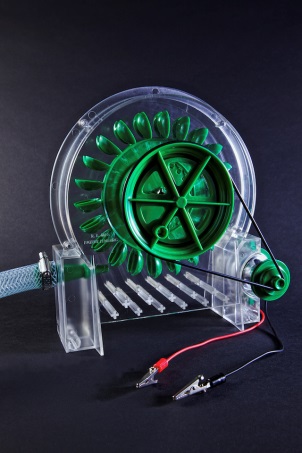By Roy Bentley of RB-MFG USA
The PowerWheel was designed to be a foundational tool for the instruction of energy and physics. The PowerWheel is a demonstration device that will aid the student development from elementary school to college, and beyond! The PowerWheel is made to be handled by the student; it is transparent, and the basic points of operation are clearly visible. The PowerWheel does not intimidate… it invites!
Let’s analyze one of the many demonstrations that are available using the PowerWheel as your discussion tool.
Every student regardless of age has been using a faucet many times a day for years. Most students are confident that they know all there is to know about faucets. Faucets deliver hot and cold water at various rates depending on how you set the taps… what else is there? This is a very important starting point as the teacher introduces the PowerWheel and shows the class that along with the water, the faucet is also delivering a considerable amount of usable power. The PowerWheel will help them understand what considerable power is there!
Every student has an array of portable electronics, from smart phones to laptops… and if students have one thing in common, is that they are all looking for the next charging opportunity. What if there was a classroom tool that could show the class that the faucet can develop sufficient power to charge any battery powered device? By hooking the PowerWheel to that simple faucet a whole array of lessons become available, including how to charge your portable devices! The teacher has taken an everyday item (the faucet) and by using 4 lbs. of plastic and a considerable amount of engineering they have a created a “eureka” moment. This is the embodiment of a STEM program!
We have found that over 90% of the students that view the PowerWheel/cell phone demonstration take this new appreciation of faucets and energy and share it with their families. In other words, the teacher has not only educated the student but also the parents – this goes an incredibly long way in building that strong partnership between the classroom and the home!
The simple demonstration of how one can use the faucet to charge a cell phone is an extremely powerful lesson on the principle of discovery. Are there other sources of energy in our world that we have overlooked? Have we really understood what source of power we’re using when using the faucet? Let’s take a look at how hydropower actually works.
Hydropower accounts for 5-10% of the total electricity produced in the USA, depending on the rainfall and other factors. Hydropower produces no emissions and is among our cleanest/greenest sources of power.
Hydropower or water power is a major misnomer as the power does not come entirely from the water. The PowerWheel or any hydropower generator would run equally as well on any liquid. The PowerWheel requires a free flowing liquid, but also requires gravity to keep the water moving. The PowerWheel is a “gravity engine”.
If you consider the water cycle, energy from the sun causes evaporation that lifts water into the atmosphere, forming clouds. The clouds produce precipitation which is pulled back to Earth by gravity. It would be more accurate to call the PowerWheel “a solar supplied gravity engine.” As the sun is fueled by a nuclear reaction, it is even more accurate to refer to the PowerWheel as a “nuclear fueled gravity engine”. If these concepts are made clear to students, then we build a solid foundation for future study.
The PowerWheel is a wonderful tool for introducing and supplementing your energy unit. The PowerWheel applicable for many topics, such as those listed below. For more information about the PowerWheel and how to order one for your classroom, visit www.rb-mfg.com.
| Water Cycle Solar Power Gravity Mass Hydrodynamics Pressure Volume Turbine Design Gear Ratios Energy Conversions Potential Energy Kinetic Energy |
 Kinetic Energy Mechanical Energy Radiant Energy Electrical Energy Chemical Energy Electroplating Electrochemistry Conservation Engines (General) Discovery AC Electricity DC Electricity Incandescent Lighting vs. LED Lighting |
Conversions of AC to DC Generators Electrical Load Electrical Resistance Energy Storage Renewable Energy Sustainability Gravity Engine Flywheel Energy Storage Watts Volts Water Use Heating and cooling with electricity |
Check out the PowerWheel website at www.rb-mfg.com for more great ideas and resources.




